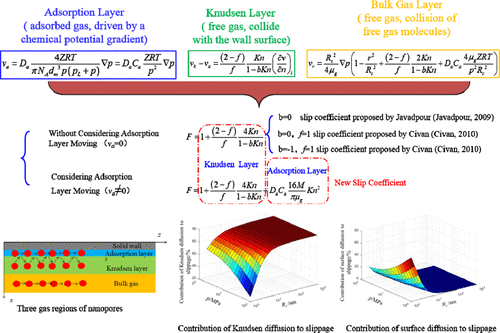当前位置:
X-MOL 学术
›
Energy Fuels
›
论文详情
Our official English website, www.x-mol.net, welcomes your
feedback! (Note: you will need to create a separate account there.)
New Slip Coefficient Model Considering Adsorbed Gas Diffusion in Shale Gas Reservoirs
Energy & Fuels ( IF 5.2 ) Pub Date : 2020-09-14 , DOI: 10.1021/acs.energyfuels.0c01689 Guanglong Sheng 1 , Yuliang Su 2 , Farzam Javadpour 3 , Wendong Wang 2 , Shiyuan Zhan 2 , Jinghua Liu 1 , Zhi Zhong 4
Energy & Fuels ( IF 5.2 ) Pub Date : 2020-09-14 , DOI: 10.1021/acs.energyfuels.0c01689 Guanglong Sheng 1 , Yuliang Su 2 , Farzam Javadpour 3 , Wendong Wang 2 , Shiyuan Zhan 2 , Jinghua Liu 1 , Zhi Zhong 4
Affiliation

|
The nanopores in shale reservoirs have large internal surface areas, and many gas molecules are adsorbed on the surface, forming an adsorption layer. The adsorption layer is mobile due to surface diffusion, which is driven by a chemical potential gradient. Traditional slip flow takes into account molecular collisions of free gas and porous surfaces but does not consider the influence of the motion of adsorption layers. In this study, free gas migration near wall surfaces is described using molecular dynamics and by considering collisions with the mobile adsorption layer. Further, a new slip coefficient model considering surface diffusion driven by a chemical potential gradient is proposed. The results show that the surface diffusion has a significant influence on gas slippage. The slip coefficient increases when considering the adsorption layer moving in small pores. When the pore pressure is less than 5 MPa and the pore radius is less than 5 nm, surface diffusion plays a dominant role in gas slippage. Based on the proposed slip coefficient, the influence of surface diffusion on the apparent porosity and transport capacity was analyzed. The results show that the apparent porosity first increases and then decreases as the pore pressure decreases; subsequently, it gradually increases as the pore radius decreases. The slip permeability and its contribution to transport capacity are greater than the viscous permeability in pores less than 10 nm, indicating that the slip effects have a significant influence on fluid flow in small pores.
中文翻译:

页岩气储集层中考虑吸附气体扩散的新滑移系数模型
页岩储层中的纳米孔具有较大的内表面积,并且许多气体分子被吸附在表面上,从而形成吸附层。由于表面扩散,吸附层是可移动的,表面扩散是由化学势梯度驱动的。传统的滑流考虑了自由气体和多孔表面的分子碰撞,但没有考虑吸附层运动的影响。在这项研究中,利用分子动力学和考虑与可移动吸附层的碰撞来描述壁表面附近的自由气体迁移。此外,提出了一种新的滑移系数模型,该模型考虑了由化学势梯度驱动的表面扩散。结果表明,表面扩散对气体滑移具有显着影响。当考虑吸附层在小孔中移动时,滑移系数增加。当孔压小于5MPa且孔半径小于5nm时,表面扩散在气体滑移中起主要作用。基于提出的滑移系数,分析了表面扩散对表观孔隙率和输运能力的影响。结果表明,随着孔隙压力的减小,表观孔隙率先增大后减小。随后,它随着孔半径的减小而逐渐增加。滑动渗透率及其对传输能力的贡献大于小于10 nm的孔隙中的粘滞渗透率,表明滑动效应对小孔隙中的流体流动具有显着影响。当孔压小于5MPa且孔半径小于5nm时,表面扩散在气体滑移中起主要作用。基于提出的滑移系数,分析了表面扩散对表观孔隙率和输运能力的影响。结果表明,随着孔隙压力的减小,表观孔隙率先增大后减小。随后,它随着孔半径的减小而逐渐增加。滑动渗透率及其对传输能力的贡献大于小于10 nm的孔隙中的粘滞渗透率,表明滑动效应对小孔隙中的流体流动具有显着影响。当孔压小于5MPa且孔半径小于5nm时,表面扩散在气体滑移中起主要作用。基于提出的滑移系数,分析了表面扩散对表观孔隙率和输运能力的影响。结果表明,随着孔隙压力的减小,表观孔隙率先增大后减小。随后,它随着孔半径的减小而逐渐增加。滑动渗透率及其对传输能力的贡献大于小于10 nm的孔隙中的粘滞渗透率,表明滑动效应对小孔隙中的流体流动具有显着影响。分析了表面扩散对表观孔隙率和输运能力的影响。结果表明,随着孔隙压力的减小,表观孔隙率先增大后减小。随后,它随着孔半径的减小而逐渐增加。滑动渗透率及其对传输能力的贡献大于小于10 nm的孔隙中的粘性渗透率,这表明滑动效应对小孔隙中的流体流动具有重大影响。分析了表面扩散对表观孔隙率和输运能力的影响。结果表明,随着孔隙压力的减小,表观孔隙率先增大后减小。随后,它随着孔半径的减小而逐渐增加。滑动渗透率及其对传输能力的贡献大于小于10 nm的孔隙中的粘滞渗透率,表明滑动效应对小孔隙中的流体流动具有显着影响。
更新日期:2020-10-16
中文翻译:

页岩气储集层中考虑吸附气体扩散的新滑移系数模型
页岩储层中的纳米孔具有较大的内表面积,并且许多气体分子被吸附在表面上,从而形成吸附层。由于表面扩散,吸附层是可移动的,表面扩散是由化学势梯度驱动的。传统的滑流考虑了自由气体和多孔表面的分子碰撞,但没有考虑吸附层运动的影响。在这项研究中,利用分子动力学和考虑与可移动吸附层的碰撞来描述壁表面附近的自由气体迁移。此外,提出了一种新的滑移系数模型,该模型考虑了由化学势梯度驱动的表面扩散。结果表明,表面扩散对气体滑移具有显着影响。当考虑吸附层在小孔中移动时,滑移系数增加。当孔压小于5MPa且孔半径小于5nm时,表面扩散在气体滑移中起主要作用。基于提出的滑移系数,分析了表面扩散对表观孔隙率和输运能力的影响。结果表明,随着孔隙压力的减小,表观孔隙率先增大后减小。随后,它随着孔半径的减小而逐渐增加。滑动渗透率及其对传输能力的贡献大于小于10 nm的孔隙中的粘滞渗透率,表明滑动效应对小孔隙中的流体流动具有显着影响。当孔压小于5MPa且孔半径小于5nm时,表面扩散在气体滑移中起主要作用。基于提出的滑移系数,分析了表面扩散对表观孔隙率和输运能力的影响。结果表明,随着孔隙压力的减小,表观孔隙率先增大后减小。随后,它随着孔半径的减小而逐渐增加。滑动渗透率及其对传输能力的贡献大于小于10 nm的孔隙中的粘滞渗透率,表明滑动效应对小孔隙中的流体流动具有显着影响。当孔压小于5MPa且孔半径小于5nm时,表面扩散在气体滑移中起主要作用。基于提出的滑移系数,分析了表面扩散对表观孔隙率和输运能力的影响。结果表明,随着孔隙压力的减小,表观孔隙率先增大后减小。随后,它随着孔半径的减小而逐渐增加。滑动渗透率及其对传输能力的贡献大于小于10 nm的孔隙中的粘滞渗透率,表明滑动效应对小孔隙中的流体流动具有显着影响。分析了表面扩散对表观孔隙率和输运能力的影响。结果表明,随着孔隙压力的减小,表观孔隙率先增大后减小。随后,它随着孔半径的减小而逐渐增加。滑动渗透率及其对传输能力的贡献大于小于10 nm的孔隙中的粘性渗透率,这表明滑动效应对小孔隙中的流体流动具有重大影响。分析了表面扩散对表观孔隙率和输运能力的影响。结果表明,随着孔隙压力的减小,表观孔隙率先增大后减小。随后,它随着孔半径的减小而逐渐增加。滑动渗透率及其对传输能力的贡献大于小于10 nm的孔隙中的粘滞渗透率,表明滑动效应对小孔隙中的流体流动具有显着影响。











































 京公网安备 11010802027423号
京公网安备 11010802027423号